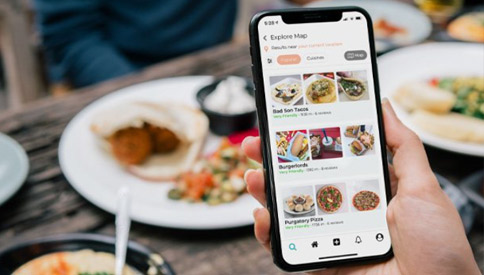Shoppers Have Changed. Here’s What Brands and Retailers Should Do About It
By Robb Powell & Todd Mitchell
Will we ever learn to recognize what’s happening in the marketplace as it’s happening and respond in real time, rather than playing catchup?
Millions of words have been written about how the pandemic is changing consumers’ shopping behavior and their move to online shopping. But their behavior — specifically using their devices to search, research, compare and buy products — isn’t changing. It had already changed. The pandemic simply accelerated it.
Now brands and retailers are working overtime to reach and convert shoppers who are sitting at their kitchen tables ordering groceries, riding as a passenger in a car checking their social media or standing in a store searching for digital coupons. They’re quickly ramping up investments in ways to reach a growing group of traditional in-store shoppers who now prefer to order groceries from anywhere then pull up to a store and have someone else put their groceries in the trunk — or leave them on their doorstep.
One thing is clear: Industry players who are winning in this fast-changing marketplace are those who no longer think in terms “channels.” They think about the consumer’s journey. Creating strategies to boost share of the physical shelf and separate strategies for increasing the share of the digital shelf will lead to missed opportunities. It’s better to think about winning a share of households and reaching shoppers on their terms.
It’s time for brands and retailers to view everything they do — from product development to supply chain and logistics to pricing to advertising and trade promotions — through a lens of “Commerce Unity,” or commerce as a whole.
Still, most brands and retailers aren’t there yet and if their leaders asked themselves, “Are we set up to sell products the way they are being bought?” an honest answer would be “We’re a work in progress.”
Here are four — surmountable — barriers to Commerce Unity:
1. The traditional structure of consumer goods and retail companies. Most businesses are still managing traditional sales separately from e-commerce sales, because that’s how e-commerce was first established. Here’s the problem with operating as if there’s a channel for digital sales and a channel for in-store sales — they’re the same channel.
The most successful brands and retailers no longer maintain a separate “e-commerce group.” Astute brands and retailers follow the shopper’s journey digitally and physically as one journey. Their commerce talent touches every function and their field sales team helps manage across the digital and physical shelf, ensuring availability, promotional support and in-stock levels for any type of shopper.
2. Traditional shopper marketing and trade promotion strategies. Should they be viewed differently in a commerce-unified world? Digital coupons, physical coupons, banners in the store, a banner on the click-and-collect app, Google advertising — what constitutes a trade spend now? Trade funds typically focus on driving store sales, but, today, what constitutes a store?
Brands are accustomed to thinking about “share of shelf” and many assume their share of the digital shelf is the same as their share of the store shelf and spend accordingly. But manufacturers need to take the time to discover how they’re performing on digital platforms and how close that is to how they’re performing in stores. Perhaps a competing brand has lost its share of the physical shelf but is spending to increase its share on the digital shelf; its success online can change the physical shelf makeup when the retailer’s buying team sees the shift in consumer demand. Even if 10% of a brand’s sales are made online, that may represent a figure that has doubled or tripled in the last year.
If a brand spends on a shopper marketing event for football season in stores, how does that event show up on digital platforms, especially if 10% of that brand’s volume goes through digital?
3. Packaging that doesn’t fit the way consumers are shopping. With products being picked at a store for curbside pickup or delivery or delivered from an Uber Eats distribution hub or dark store, packaging must be optimized for Commerce Unity opportunities — appealing to shoppers in stores and as a digital image and holding up through a variety of last-mile options.
Recognizing the opportunity to support packaging innovation that can span the breadth of consumer shopping preferences is important.
4. The need for hyper-local physical and digital assortment. With Walmart, Albertsons and others operating dark stores and Kroger’s Ocado partnership supporting fulfillment of online orders, the entire supply chain is under scrutiny and will need transforming. Localization of assortments will continue to take on greater importance as physical space limitations meet expanded digital options. What products are found on store shelves? Which on the digital shelf? And does it really matter where any of these items are housed if they are delivered to a store for pickup or delivered directly to a shopper’s address?
Commerce Unity is focused on thinking about a shopper’s purchase as a nonlinear journey through an ecosystem, rather than a specific event. Investing funds — trade, shopper, marketing, media, online or in-store — in a strategic, holistic manner to amplify brands at all points during that journey is crucial.
Finding business partners who see the need for this type of holistic approach is equally important. Our recommendation: Move fast, be flexible, test and learn, pivot as needed and think differently — because your shopper is thinking and acting differently and evolving every day.
Playing catch up or purposefully lagging will ensure a brand or retail banner falls behind at the precise time shoppers are accelerating their rate of change. Now, more than ever before, playing to win is critical.






